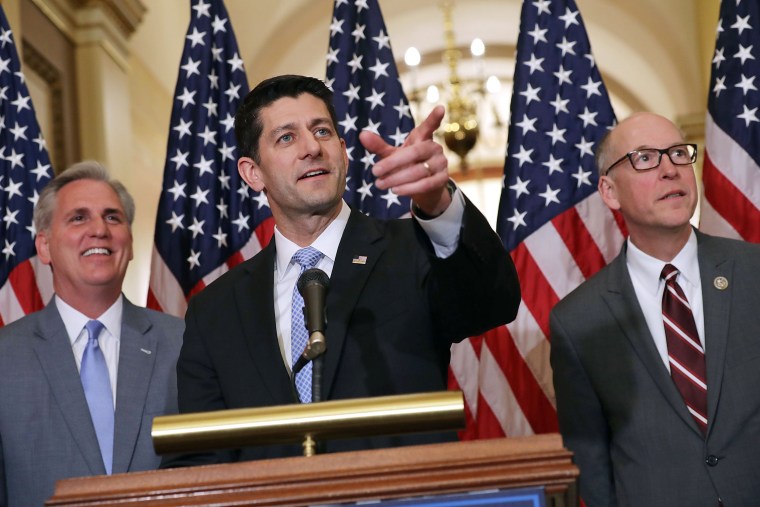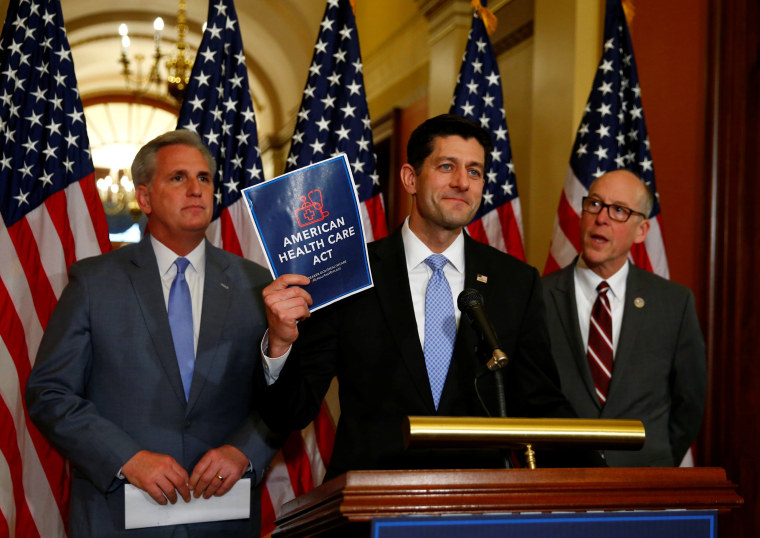The American Health Care Act (AHCA), the Republican plan to replace the Affordable Care Act, is wending its way through the congressional approval process.
It’s catching heat from virtually all quarters — doctors and nurses, hospitals and the AARP, conservatives, liberals and even the right-wing Heritage Foundation.

And yet President Donald Trump has given it his blessing — and GOP leaders say they are determined to push it through. Here are five things to know about the plan:
It can’t fully repeal Obamacare
“Repeal and replace” has been the refrain of Republicans for years; Trump issued an executive order on the very day he took the oath of office that directed agencies to ease the regulatory burdens it imposed. But a president cannot repeal a law passed by Congress, and Congress can’t even repeal one of its own laws without the votes.
To repeal Obamacare, the Senate needs 60 votes. There are only 52 Republican senators, so the Republicans are instead using a budget process called reconciliation to pass the AHCA. That only takes a 51-vote majority. The catch? Every measure has to have a budgetary impact.
It would redefine Medicaid
Some experts believe this could be the biggest overall effect of the AHCA long term if it is passed.
Obamacare required states to expand the Medicaid program — the joint state-federal health insurance plan for the poor, disabled, pregnant women and for some elderly — to cover more people. The Supreme Court ruled that was voluntary and only 30 states, plus Washington, D.C., opted to expand. An estimated 11 million people got health insurance through this expansion, which was 100 percent paid for by the federal government at first before gradually rolling back to 90 percent.
Related: Many Experts Say the GOP Plan Won't Work
Republicans argue this open-ended federal spending is out of control. The AHCA provides a per capita federal contribution to Medicaid starting in 2020. This starts to put the onus back on states to pay rising health care costs for Medicaid enrollees. Supporters of the AHCA say this provides an incentive to keep costs down and gives states flexibility to decide what’s best. Critics say it’s a formula for weakening Medicaid, which currently covers about 70 million people.
It may take away benefits
Obamacare lays out 10 "essential benefits” that most health insurance policies must cover. They include outpatient care, emergency services, hospitalization, maternity and newborn care, mental health services and addiction treatment, prescription drugs, rehabilitative services, laboratory tests, preventive services (including cancer screenings and vaccines) and pediatric services.
Related: Five Things You May Not Have Known About Obamacare
The AHCA takes away the requirement that Medicaid cover these benefits. That means some states can drop them for Medicaid enrollees — and many almost certainly will as they get into cost crunches. This could hit mental health and addiction coverage especially hard.
It also takes federal funding away from Planned Parenthood and any other health provider that offers abortion, even though federal law already prohibits the use of taxpayer dollars for abortion.
It will probably make health insurance more expensive
Obamacare heavily subsidized insurance premiums. An estimated 85 percent of the 10 million to 12 million people buying individual insurance on the exchanges got a federal subsidy. Plus, it provided help with other costs. The AHCA stops the subsidies, which varied state by state and according to a customer’s income using a complicated formula. Instead, the AHCA provides a much simpler tax credit of $2,000 to $4,000 per person.
Related: Health Care Bill Cuts Crucial Disease Prevention Fund
The nonpartisan Kaiser Family Foundation estimates the credit averages out to $1,700 less per person. Almost all projections say the tax credit will help higher-income people more and lower-income people less.
People complained that insurance premiums rose under Obamacare and they did. But they were rising long before Obamacare, and rose for non-Obamacare plans, also.
Fewer people will have health insurance
Few dispute that the Obamacare law got more people covered by health insurance – 20 million people more, by most estimates. It was also designed to ensure that this was quality insurance that would actually cover people for their claims. Republicans say they want to expand access to health insurance, which is not quite the same thing as making sure people get covered, and they say they want people to have the choice to choose bare-bones plans if they want to.
Related: Paul Ryan's PowerPoint on the AHCA
The Brookings Institution projects that 15 million fewer people with end up with health insurance under the AHCA. The nonpartisan Congressional Budget Office is due to release its estimate next week.
“Insurance is not really the end goal here,” White House Office of Management and Budget Director Mick Mulvaney told MSNBC this week.
One way Obamacare aimed to make sure people had coverage was through mandates. People had to pay an extra tax if they didn’t have health insurance for most of the year. The new plan would let health insurance companies charge clients 30 percent higher premiums for a year if they do not stay continuously insured.

